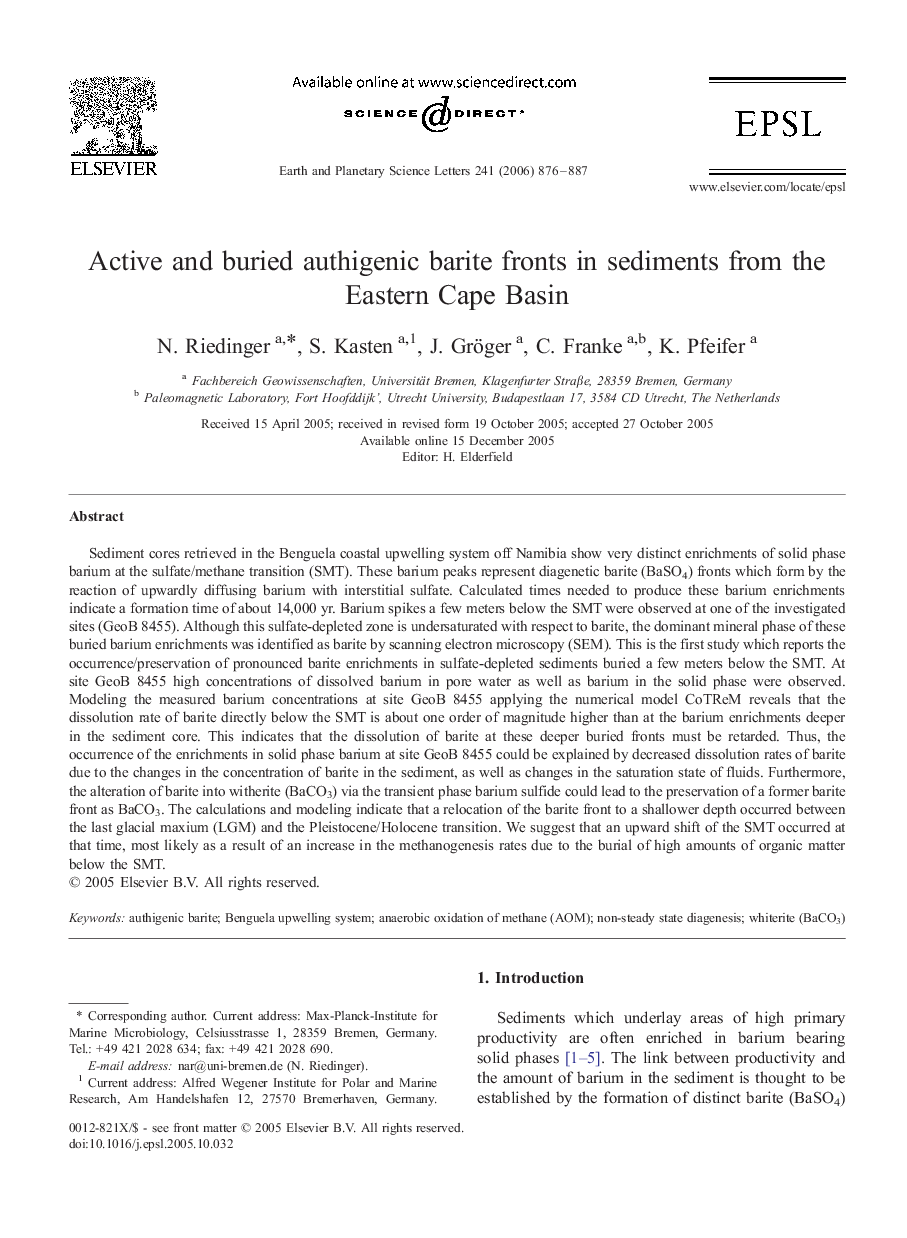| کد مقاله | کد نشریه | سال انتشار | مقاله انگلیسی | نسخه تمام متن |
|---|---|---|---|---|
| 4681225 | 1634952 | 2006 | 12 صفحه PDF | دانلود رایگان |
عنوان انگلیسی مقاله ISI
Active and buried authigenic barite fronts in sediments from the Eastern Cape Basin
دانلود مقاله + سفارش ترجمه
دانلود مقاله ISI انگلیسی
رایگان برای ایرانیان
کلمات کلیدی
موضوعات مرتبط
مهندسی و علوم پایه
علوم زمین و سیارات
علوم زمین و سیاره ای (عمومی)
پیش نمایش صفحه اول مقاله

چکیده انگلیسی
Sediment cores retrieved in the Benguela coastal upwelling system off Namibia show very distinct enrichments of solid phase barium at the sulfate/methane transition (SMT). These barium peaks represent diagenetic barite (BaSO4) fronts which form by the reaction of upwardly diffusing barium with interstitial sulfate. Calculated times needed to produce these barium enrichments indicate a formation time of about 14,000 yr. Barium spikes a few meters below the SMT were observed at one of the investigated sites (GeoB 8455). Although this sulfate-depleted zone is undersaturated with respect to barite, the dominant mineral phase of these buried barium enrichments was identified as barite by scanning electron microscopy (SEM). This is the first study which reports the occurrence/preservation of pronounced barite enrichments in sulfate-depleted sediments buried a few meters below the SMT. At site GeoB 8455 high concentrations of dissolved barium in pore water as well as barium in the solid phase were observed. Modeling the measured barium concentrations at site GeoB 8455 applying the numerical model CoTReM reveals that the dissolution rate of barite directly below the SMT is about one order of magnitude higher than at the barium enrichments deeper in the sediment core. This indicates that the dissolution of barite at these deeper buried fronts must be retarded. Thus, the occurrence of the enrichments in solid phase barium at site GeoB 8455 could be explained by decreased dissolution rates of barite due to the changes in the concentration of barite in the sediment, as well as changes in the saturation state of fluids. Furthermore, the alteration of barite into witherite (BaCO3) via the transient phase barium sulfide could lead to the preservation of a former barite front as BaCO3. The calculations and modeling indicate that a relocation of the barite front to a shallower depth occurred between the last glacial maxium (LGM) and the Pleistocene/Holocene transition. We suggest that an upward shift of the SMT occurred at that time, most likely as a result of an increase in the methanogenesis rates due to the burial of high amounts of organic matter below the SMT.
ناشر
Database: Elsevier - ScienceDirect (ساینس دایرکت)
Journal: Earth and Planetary Science Letters - Volume 241, Issues 3â4, 31 January 2006, Pages 876-887
Journal: Earth and Planetary Science Letters - Volume 241, Issues 3â4, 31 January 2006, Pages 876-887
نویسندگان
N. Riedinger, S. Kasten, J. Gröger, C. Franke, K. Pfeifer,